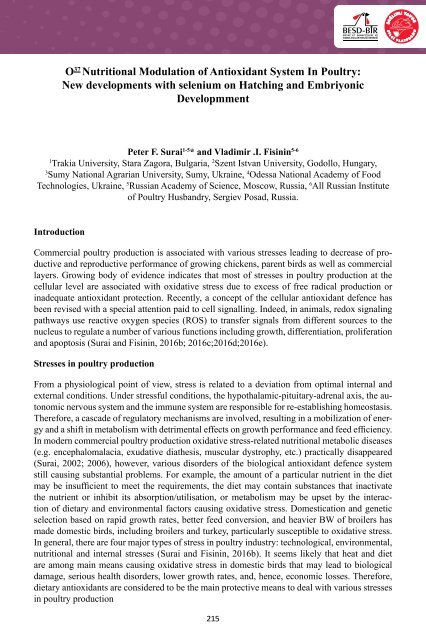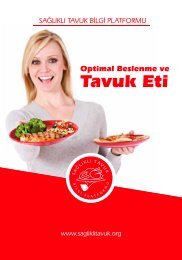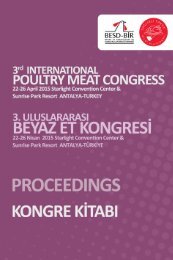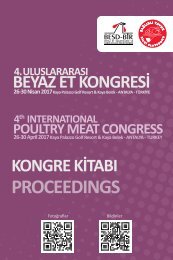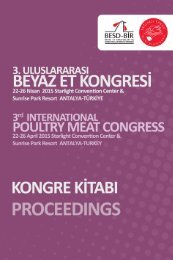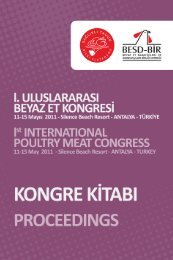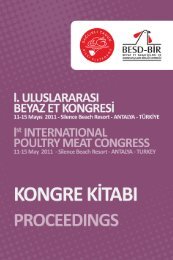4th International Poultry Meat Congress
PROCEEDINGS
PROCEEDINGS
You also want an ePaper? Increase the reach of your titles
YUMPU automatically turns print PDFs into web optimized ePapers that Google loves.
O 37 Nutritional Modulation of Antioxidant System In <strong>Poultry</strong>:<br />
New developments with selenium on Hatching and Embriyonic<br />
Developmment<br />
Peter F. Surai 1-5 * and Vladimir .I. Fisinin 5-6<br />
1<br />
Trakia University, Stara Zagora, Bulgaria, 2 Szent Istvan University, Godollo, Hungary,<br />
3<br />
Sumy National Agrarian University, Sumy, Ukraine, 4 Odessa National Academy of Food<br />
Technologies, Ukraine, 5 Russian Academy of Science, Moscow, Russia, 6 All Russian Institute<br />
of <strong>Poultry</strong> Husbandry, Sergiev Posad, Russia.<br />
Introduction<br />
Commercial poultry production is associated with various stresses leading to decrease of productive<br />
and reproductive performance of growing chickens, parent birds as well as commercial<br />
layers. Growing body of evidence indicates that most of stresses in poultry production at the<br />
cellular level are associated with oxidative stress due to excess of free radical production or<br />
inadequate antioxidant protection. Recently, a concept of the cellular antioxidant defence has<br />
been revised with a special attention paid to cell signalling. Indeed, in animals, redox signaling<br />
pathways use reactive oxygen species (ROS) to transfer signals from different sources to the<br />
nucleus to regulate a number of various functions including growth, differentiation, proliferation<br />
and apoptosis (Surai and Fisinin, 2016b; 2016c;2016d;2016e).<br />
Stresses in poultry production<br />
From a physiological point of view, stress is related to a deviation from optimal internal and<br />
external conditions. Under stressful conditions, the hypothalamic-pituitary-adrenal axis, the autonomic<br />
nervous system and the immune system are responsible for re-establishing homeostasis.<br />
Therefore, a cascade of regulatory mechanisms are involved, resulting in a mobilization of energy<br />
and a shift in metabolism with detrimental effects on growth performance and feed efficiency.<br />
In modern commercial poultry production oxidative stress-related nutritional metabolic diseases<br />
(e.g. encephalomalacia, exudative diathesis, muscular dystrophy, etc.) practically disappeared<br />
(Surai, 2002; 2006), however, various disorders of the biological antioxidant defence system<br />
still causing substantial problems. For example, the amount of a particular nutrient in the diet<br />
may be insufficient to meet the requirements, the diet may contain substances that inactivate<br />
the nutrient or inhibit its absorption/utilisation, or metabolism may be upset by the interaction<br />
of dietary and environmental factors causing oxidative stress. Domestication and genetic<br />
selection based on rapid growth rates, better feed conversion, and heavier BW of broilers has<br />
made domestic birds, including broilers and turkey, particularly susceptible to oxidative stress.<br />
In general, there are four major types of stress in poultry industry: technological, environmental,<br />
nutritional and internal stresses (Surai and Fisinin, 2016b). It seems likely that heat and diet<br />
are among main means causing oxidative stress in domestic birds that may lead to biological<br />
damage, serious health disorders, lower growth rates, and, hence, economic losses. Therefore,<br />
dietary antioxidants are considered to be the main protective means to deal with various stresses<br />
in poultry production<br />
215


